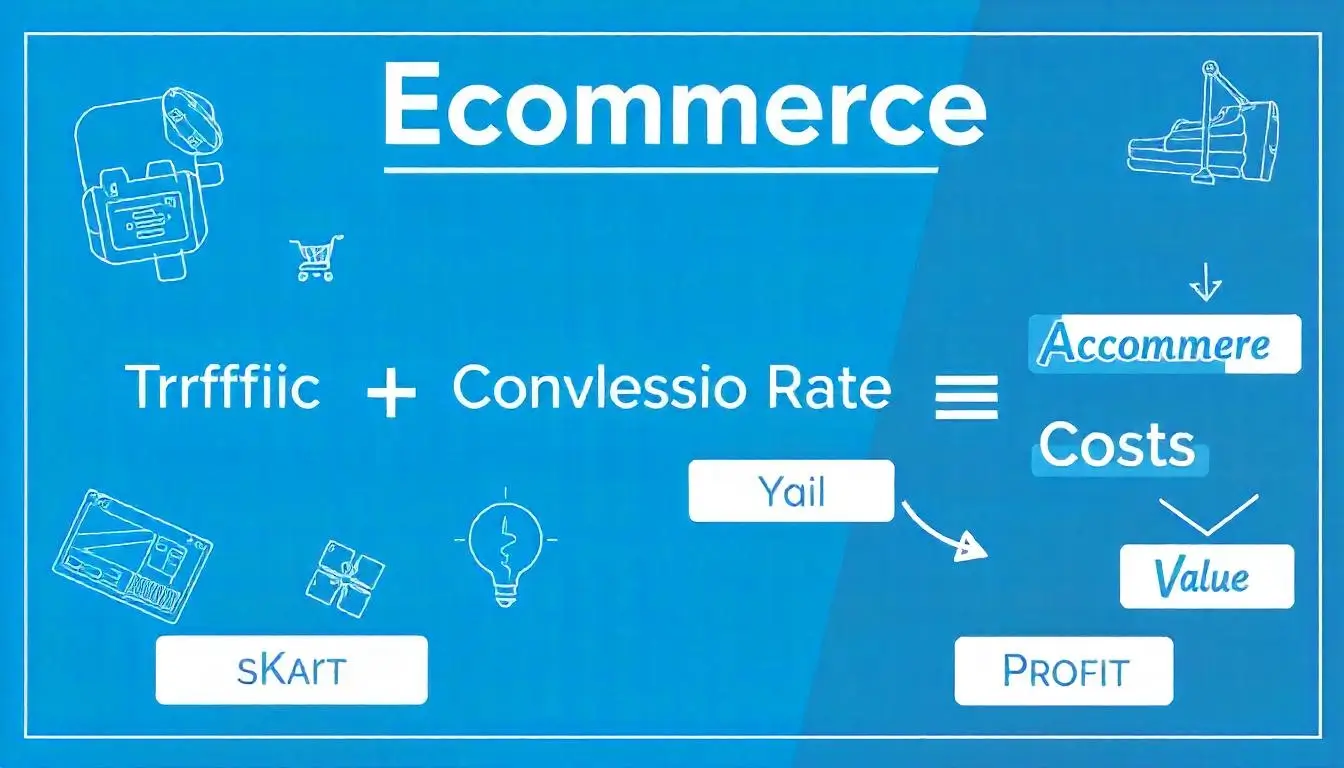Crack the Ecommerce Equation: The Formula for Success in 2025
The ecommerce equation is the foundation of a successful online business. With ecommerce evolving rapidly, understanding and applying the right formula in 2025 will be the key to staying ahead of the competition.
In this guide, we break down the ecommerce equation and how you can use it to maximize traffic, boost conversions, and drive profits.
What is the Ecommerce Equation?

The ecommerce equation is a proven formula that determines how profitable an online business can be:
Ecommerce Success = (Traffic × Conversion Rate × Average Order Value) - Costs
- Traffic: The number of visitors to your online store.
- Conversion Rate (CR): The percentage of visitors who make a purchase.
- Average Order Value (AOV): The average amount spent per transaction.
- Costs: Expenses related to marketing, fulfillment, and operations.
By optimizing each of these factors, you can increase revenue and improve profitability in 2025.
Step 1: Driving High-Quality Traffic
Getting traffic is the first step in the ecommerce equation. But not just any traffic—targeted visitors who are likely to convert.
SEO Optimization for Ecommerce
- Focus on high-intent keywords (e.g., “buy [product] online” or “best [product] for [use case]”).
- Optimize product pages, images, and meta descriptions for search engines.
- Publish helpful blog content that answers customer queries and improves organic reach.
Social Media & Influencer Marketing
- Use Instagram, TikTok, and Pinterest to showcase your products.
- Partner with influencers to gain credibility and reach a wider audience.
- Leverage user-generated content (UGC) to drive engagement and trust.
Paid Advertising & Retargeting
- Use Google Ads & Facebook Ads for targeted campaigns.
- Run retargeting ads for visitors who left without making a purchase.
- A/B test ad creatives and copy to improve conversion rates.
Step 2: Optimizing Conversion Rate (CR)

More-traffic is great, but without a solid conversion strategy, it won’t lead to more sales.
Enhancing Website User Experience (UX)
- Ensure fast load times (under 3 seconds).
- Optimize for mobile devices, as mobile ecommerce sales continue to rise.
- Improve site navigation and product categorization to help users find what they need quickly.
Building Trust & Reducing Friction
- Display customer reviews and ratings prominently.
- Offer secure payment options (PayPal, Apple Pay, Google Pay, Buy Now Pay Later).
- Show trust badges and clear return policies.
Improving Checkout Process
- Reduce the number of checkout steps.
- Offer a guest checkout option to minimize friction.
- Use exit-intent popups to capture abandoned carts.
Step 3: Increasing Average Order Value (AOV)
A higher AOV means more revenue per customer, increasing profitability without needing more traffic.
Upselling & Cross-Selling
- Recommend premium versions of products at checkout.
- Suggest related products to increase cart value.
- Offer bulk purchase discounts to encourage higher spending.
Bundles & Subscription Models
- Create product bundles with complementary items.
- Introduce a subscription model for recurring purchases (e.g., beauty products, supplements, or pet supplies).
Loyalty & Rewards Programs
- Reward repeat customers with points and exclusive discounts.
- Implement a referral program to bring in new customers.
Step 4: Managing Costs for Maximum Profitability
While increasing revenue is essential, reducing costs ensures your business remains profitable.
Optimizing Fulfillment & Shipping
- Use third-party logistics (3PL) to reduce shipping costs.
- Offer free shipping on orders over a certain value to encourage higher spending.
- Reduce packaging costs by using eco-friendly, lightweight materials.
Reducing Marketing & Customer Acquisition Costs
- Focus on organic growth through SEO and social media.
- Use AI-driven tools to optimize ad targeting and reduce ad spend.
- Encourage word-of-mouth referrals by providing excellent customer service.
Inventory Management & Supplier Negotiation
- Avoid overstocking and dead inventory with real-time tracking.
- Negotiate better rates with wholesalers and suppliers.
- Consider dropshipping for select products to lower upfront costs.
Ecommerce Success in 2025: Key Trends to Watch
To stay ahead in 2025, you need to adapt to emerging ecommerce trends. Here’s what to watch:
1. AI & Personalization
- AI-powered chatbots for instant customer support.
- Personalized product recommendations based on browsing behavior.
2. Voice Search & Visual Shopping
- Optimize for voice search by using natural language keywords.
- Implement image search functionality to help users find products easily.
3. Sustainability & Ethical Shopping
- More consumers prefer eco-friendly and ethical brands.
- Highlight sustainable practices in marketing efforts.
4. Social Commerce Growth
- Shopping directly on Instagram, TikTok, and Facebook.
- Use shoppable posts and live shopping events to increase sales.
Final Thoughts: Mastering the Ecommerce Equation in 2025
Success in ecommerce comes down to optimizing the core components of the ecommerce equation:
✅ Increase Targeted Traffic with SEO, paid ads, and social media. ✅ Improve Conversion Rates through UX improvements, trust signals, and better checkout flows. ✅ Boost Average Order Value with upsells, bundles, and loyalty programs. ✅ Reduce Costs & Improve Efficiency with better supplier deals, smart shipping, and organic marketing.
By continuously refining your ecommerce strategy and adapting to new trends, you can build a thriving, profitable online store in 2025 and beyond.
Are you ready to crack the ecommerce equation and scale your business? Start applying these strategies today! 🚀
Stay ahead of the ecommerce game—subscribe to our newsletter for more expert insights!
- Start Earning: How to Make Money on Taobao Without Big Investment
- Can You Use PayPal on Taobao? Here’s What You Need to Know (2025 Update)
- AI vs. Manual Ecommerce Management: What’s More Effective in 2025?
- Shopify 1099-K Reporting Rules Are Changing: How It Affects Your Online Store
- AliExpress vs Amazon: Which Is Better for Budget Shoppers?
- Is AliExpress Safe in 2025? What Buyers Need to Know Today
- Why Is Pandabuy So Popular? A Deep Dive into Its Rise on Social Media
- How Safe Is Pandabuy? What Every New Shopper Should Know
- How to Use Pandabuy in 2025: Step-by-Step for First-Time Buyers
- Taobao Shipping Explained: Delivery Times & Costs in 2025
- Taobao Payment Not Working Internationally? Here’s Why
- Shopify Experts vs DIY: What’s Best for Your Business?
- Top Dropshipping Businesses to Start in 2025
- How to Use Taobao in English: A Step-by-Step Guide
- Taobao Login Issues & Link Sharing Problems: How to Fix Them
- Is Taobao Safe? What You Need to Know Before Buying
- Shogun Shopify: The Best Page Builder for Your Store
- Magento Marketplace vs Shopify: Which Platform is Best for Sellers?
- How to Hire a WooCommerce Expert: Skills, Costs, and Best Platforms
- Ecommerce Fulfillment Services: How to Choose the Best Solution for Your Business
- Ecommerce explicado: Tipos, beneficios y claves del éxito
- Ecommerce: ¿Qué es y cómo empezar tu tienda online en 2025?
- The Ecommerce Equation: Unlocking Profitable Online Sales Strategies
- Crack the Ecommerce Equation: The Formula for Success in 2025
- Retail Ecommerce Ventures: Transforming Brands into Online Success in 2025
- Ecommerce Photography Tips: Shoot Stunning Product Images Like a Pro
- Best Cameras and Tools for Ecommerce Photography in 2025
- Top B2B Ecommerce Solutions for 2025: Powering Your Business Growth
- How to Choose the Best B2B Ecommerce Solution: A Complete Guide
- Best Ecommerce Website Creators for 2025: Build Your Store in Minutes
- 5 Reasons Why Ecommdirect is a Game-Changer for Online Retailers
- EcommDirect: The Future of Seamless Online Shopping in 2025
- Connective Ecommerce: The Future of Seamless Online Shopping
- Top Ecommerce Web Development Services in Melbourne for 2025
- Ecommerce Web Development Melbourne: Build a High-Converting Online Store
- Top Tips for Choosing the Right Ecommerce Advertising Agency
- Why Every Online Store Needs an Ecommerce Advertising Agency
- Boost Your Sales with the Best Ecommerce Advertising Agency in 2025
- Magento vs. Other Ecommerce Platforms: Which is Best for Your Store?
- Top Features of the Magento Ecommerce Platform You Need to Know
- How to Boost Sales with the Magento Ecommerce Platform
- Top Ecommerce SEO Experts: Boost Your Online Store Traffic
- Why Hiring Ecommerce SEO Experts Is a Game-Changer for Your Store
- Ecommerce Website Development in Dubai: Build Your Store for Success
- Protect Your Online Store with the Right Business Insurance
- Top Insurance Options for Ecommerce Entrepreneurs
- Taobao Shopping Made Easy: Tips for Global Buyers
- Ecommerce Business Insurance: Why It Matters in 2025
- Why Ecommerce Business Is the Best Startup Option Today
- Ecommerce Business Marketing Strategies That Drive Sales
- 10 Common Mistakes to Avoid When Starting an Ecommerce Business
- The Future of Ecommerce Business: Trends to Watch in 2025
- Ecommerce Business Essentials: Tools, Tips, and Strategies for Beginners
- Top 10 Ecommerce Business Ideas to Boost Your Revenue This Year
- How to Start a Successful Ecommerce Business in 2025: A Step-by-Step Guide
- Unlock the Power of Odoo Ecommerce: The Ultimate Solution for Your Online Store
- Expert Ecommerce Website Development Services for Your Store
- Expert Guide to Ecommerce Website Development in Dubai: Build Your Dream Online Store
- Top eCommerce Website Development Companies: Build Your Dream Online Store Today
- Streamlining E-commerce Product Updates with GitHub Workflows
- Monetize Your E-commerce Open-source Projects: A Beginner’s Guide to GitHub Sponsors
- Collaborating with Freelancers on GitHub for E-commerce Projects
- The Role of GitHub in Supporting Multi-language E-commerce Sites
- Using GitHub Actions for E-commerce SEO Audits
- Creating and Managing API Documentation for E-commerce Platforms on GitHub
- Mastering Ecommerce Website Development with GitHub: Tools, Tips, and Best Practices
- Optimizing E-commerce Performance with GitHub Monitoring Tools
- Top GitHub Integrations for Streamlining E-commerce Development and Operations
- Managing Ecommerce Data with GitHub and Git LFS
- Version Control for E-commerce Teams: A Guide to Using Git and GitHub.
- Using GitHub Projects to Manage E-commerce Site Development
- Top GitHub Repos for Enhancing Security on Your E-commerce Site
- Securing Your E-commerce Codebase: Managing Access and Permissions in GitHub
- Managing E-commerce Data with GitHub and Git LFS
- Leveraging GitHub Pages for a Minimalist E-commerce Store


